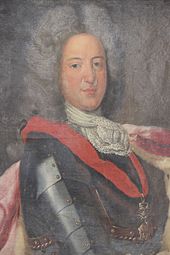Charles Henri de Lorraine-Vaudémont
Charles Henri de Lorraine-Vaudémont, prince de Commercy , German Karl Heinrich Prinz von Lothringen-Vaudémont (born April 17, 1649 in Brussels , † January 14, 1723 at Château de Commercy ), was a French nobleman , pretender to the throne for the Duchy of Lorraine and Bar , Spanish governor of Milan from 1698 to 1706 and granted the Principality of Commercy in 1708 by Duke Leopold of Lorraine .
Life
Origin and family
The first marriage of Duke Charles IV of Lorraine (1604–1675) with Nicole de Lorraine remained childless. Charles Henri de Lorraine was the third child from his second marriage with Béatrix de Cusance (* December 27, 1614 - June 5, 1663), Baronesse de Belvoir. Duke Charles' second marriage, which he led in exile in Brussels, was canonically not recognized because the Holy See did not allow the separation from Nicole de Lorraine . The illegitimate born Charles Henri de Lorraine received after his birth the title of Monsieur le Comte de Vaudémont .
Charles Henri's claim to the Lorraine inheritance was hotly contested, as rule over the duchy had been transferred to one of his nephews through French intervention. On April 27, 1669, he married his cousin Anne Elisabeth de Lorraine (* August 6, 1649 - August 5, 1714), daughter of Charles II. De Lorraine, Duke of Elbeuf from the House of Guise, in Bar-le-Duc . The princess came to be known as Mademoiselle d'Elbeuf. On March 7, 1670, a son, Charles Thomas de Lorraine , was born, who took over the title of Prince of Vaudémont from his father, while the latter now called himself Prince of Commercy.
Military career
Like his father, Charles Henri also served as a military leader in foreign military service against the French. He served nine years under William of Orange in the Netherlands. On August 11, 1674, he led the allied cavalry in the battle of Seneffe . In 1675 he was made Knight of the Order of the Golden Fleece . He also entered into negotiations with the opposing leadership and achieved that his two nieces, the Princess of Epinoy and Béatrice Hiéronyme de Lorraine, later abbess of Remiremont, were accepted into the household of the Grand Dauphin . In 1698 he was appointed Spanish governor of Milan . When the last Spanish Habsburg Charles II died in 1700 , Charles Henri was left in office by Philip of Anjou . The new King of Spain accepted the Prince of Vaudémont as governor of Lombardy , but remained suspicious. The fact remained, however, that his only son, Charles Thomas, died childless on May 12, 1704 in the battle of Ostiglia on the imperial side as the imperial military leader . After the battle of Turin , the Spanish and French were forced to withdraw from Italy. Charles Henri signed a contract with Prince Eugene of Savoy on September 26, 1706 , which brought Lombardy and Milan under the rule of the emperor.
In 1708 Charles Henri was given the small principality of Commercy by the Duke of Lorraine. The prince hired the famous architect Germain Boffrand to furnish the castle of Commercy. Charles Henri de Lorraine died at the age of 73 in the castle of Commercy , the rule was transferred to the widow of Duke Leopold, Élisabeth Charlotte de Bourbon-Orléans .
Web links
literature
- Léonce Pingaud: Le prince Charles-Henri de Vaudémont . Dodivers, Besançon 1879.
- Augustin Calmet : Histoire de Lorraine , Vol. 6, Nancy 1757, p. 520.
| personal data | |
|---|---|
| SURNAME | Lorraine-Vaudémont, Charles Henri de |
| ALTERNATIVE NAMES | Vaudémont, Charles Henri de Lorraine, prince de; Vaudémont, Charles Henri, Prince of Commercy |
| BRIEF DESCRIPTION | French nobleman and military leader |
| DATE OF BIRTH | April 17, 1649 |
| PLACE OF BIRTH | Brussels |
| DATE OF DEATH | January 14, 1723 |
| Place of death | Commercy |

